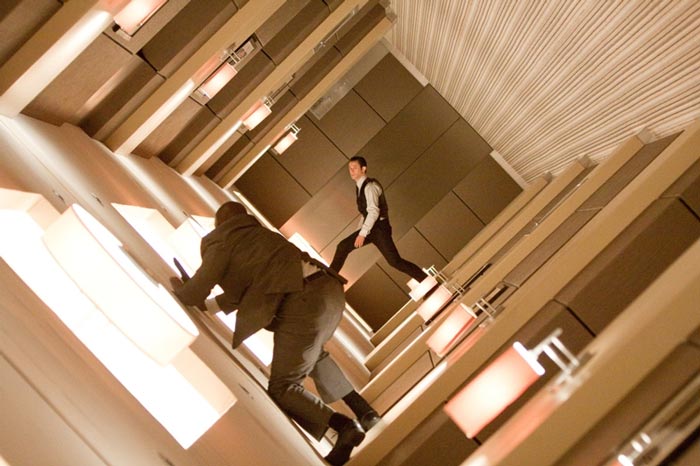Inception (Warner Bros.)
So here’s the problem with Inception. Molded from remarkable ambition and complexity, the film must spend a considerable amount of time introducing and explaining its significant set of rules and procedures. At the same time, Inception requires us to understand these rules—to grasp this intricate swirl of concepts—in order to appreciate, to experience their application within a maddeningly complicated—and yes, captivating—surreality.
For whatever reason—be it time constraints, studio expectations, or simple lack of resourcefulness—neither side of the coin (the learning on one, the experiencing on the other) is able to fully flourish (and a deficit on one side further impairs the other), and Inception fails to meet the tremendous potential of its premise.
As for that premise, I won’t even attempt to explain it in full here. To be honest, I probably couldn’t if I tried; hasty scenes of heavy exposition made sure of that. In a (very large) nutshell, agents specializing in subconscious espionage manipulate the fragile dream state to extract information from their sleeping targets. How they do this is where things get perilously tricky (it involves a suitcase device made of wires and tubes, no doubt accompanied by a thick instruction manual), but each member of the team serves a specific purpose.
Leonardo DiCaprio headlines as Dom Cobb, the “extractor,” or acting manager of the crew. He oversees each operation and, once inside the dreamscape, sways the target (fleetingly dubbed “the mark”) to fill the surroundings with his secrets. Hyper-drama mainstay Leonardo DiCaprio revisits here the crackling urgency of his Shutter Island performance; only this time, our connection to his nerviness is woefully thin.
Arthur (Joseph Gordon-Levitt) is somewhat Cobb’s sidekick and also the “point-man,” responsible for ensuring the safety and stability of the dream. (The dream begins to decay if the target realizes that something is off, and properly trained targets can enlist their subconscious “projections” to fight back against invaders.) Tom Hardy’s Eames can, as “the forger,” take the form of other humans to facilitate the charade of a normal dream (whatever that is). “The architect,” the one to physically design and realize the layout of the dreaming world, becomes the newly-recruited Ariadne (Ellen Page), who also helps introduce us to the subconscious “extraction” process via her training and conversations with Cobb.
The gang is licensed by a businessman named Saito (Ken Watanabe) to infiltrate the mind of a competitor (Cillian Murphy)—not to “extract” information as is routine, but to plant a new idea as if it were the dreamer’s own. This process (proclaimed “impossible” multiple times, and therefore all but certain to be attempted), the act of suggesting a concept to an unconscious target in the guise of personal inspiration, is heralded (and heralded, and heralded) as “inception.”
Did you follow that? Me neither. And that’s just Inception 101. That we must essentially learn, comprehend, and then apply highly detailed, graduate-level material borders on exasperating. And yet the entire ordeal, as confounding as it may be, is never short of fascinating.
If nothing else, director Christopher Nolan has shown time and again that he knows how to dazzle an audience (his filmography includes The Prestige, Batman Begins, and The Dark Knight)—to fill our senses with the purest form of awe. Inception features mind-bending visual constructions—a streetscape folding back onto itself, a physics-defying fight scene on ceilings and walls, decaying skyscrapers bursting into fragments—captured with brooding precision by cinematographer Wally Pfister, and strung together with a taught, thunderous immediacy by film editor Lee Smith (guided by Hans Zimmer’s ubiquitous and equally thunderous score).
As fuel to the fires of our immediate perceptions, Inception is about as powerful, as marvelous as it gets. Technical Oscar nods, if not wins, are all but certain. Running at just under two-and-a-half hours, the film roars past at a feverish pace. But within its compaction of visual splendor, logistical calculation, and near incessant explanation, I have to wonder, so what? Where, aside from the very superficial (as deep as this sort of superficial can be felt), is the art? Where is the feeling? Where is the emotion?
Inception is so very cold: its steely, glass-and-gears design matches a seeming disinterest in everything but mechanical concepts. The simplest of considerations (and most basic narrative requirements) go unaddressed by Nolan. What of the morality of invading someone else’s subconscious? What of the greater effects—the emotional, the spiritual—of engaging in subconscious subterfuge, of manipulating and moving through layers of reality? Who are these characters, aside from their roles as carefully placed pawns in Christopher Nolan’s Inception game?
The closest we get to personal insight comes from the spectral presence of “Mal,” Cobb’s dearly departed wife, and routine invader of his subconscious space. Cobb’s refusal to put his memories of her to rest has a nasty tendency of sabotaging his dream-world reconnaissance work. Though she plays a mere shadow, a splintered soul, Marion Cotillard wields a devastating intensity as she both haunts and is haunted by the infinite possibilities of a dreaming unreality. If the Oscar conversation for Cotillard’s performance has not yet begun, it’s surely, and deservedly, imminent. When Mal appears, the emotional stakes are considerably raised; then Christopher Nolan goes on to explain away her purpose of being. Once again, calculation triumphs over feeling.
But for that pesky deficiency in deeper exploration (and obsession with the explaining game), Inception comes frustratingly close to playing as a masterpiece. The size of its ambition, the audacity of its technique, the seduction of its concept has a steamrolling effect that I haven’t felt from a film in quite some time. Not since James Cameron’s feted groundbreaker Avatar (and before that, who knows when?) have I left the theater craving a return to a cinematic idea.
Christopher Nolan has proven himself the ultimate dream-weaver; perhaps next time, he can build a sturdier bridge into our reality. With this in mind, I would welcome a sequel to Inception–one that is as finely tuned to the layers of artistry as it is to the layers of the subconscious mind. I’d even be eager to give it a whirl in 3D. Now those are two things you won’t hear from me too often.

Written and directed by Christopher Nolan.
Rated PG-13 for sequences of violence and action throughout.
Runtime is 2 hours, 28 minutes.
Tickets & Showtimes» Watch the Trailer» Visit the Website»






But do we really have to learn, comprehend, and apply it?
or can we just accept, trust and enjoy it?
In any case you just made warner bros. happy.
Basically, the movie is good enough to see, but too complicated to only see once.
I like Nolan’s other movies and the cast, so I’ll see it.
Agreed. All that complexity and in the end all we really want to know is whether he’s in or out. My head hurts, That’s all I’m saying.
“Did you follow that? Me neither. And that’s just Inception 101. That we must essentially learn, comprehend, and then apply highly detailed, graduate-level material borders on exasperating.”
Actually I did follow it. I wish more films would do aim at graduate level quite frankly. Me, and the four other 17 year olds I was with understood it, and the general consensus is the film is a masterpiece. Clearly though, if you cannot get your head around those simple bits, then you’re not going to take away very much at all from it.
INCEPTION MOVIE HERALDS 528 CODE FOR MUSICAL TRANSCENDENCE
Wake up or die in the nightmares of corporate espionage, greed, corruption, and armed anger. INCEPTION writer and director, Christopher Nolan, heralds “528” as the “code” through which social transformation, involving music, is achieved.
The new Hollywood blockbuster has moviegoers nationwide curious about the source of a mysterious code used in the plot involving music played in “Room 528,” and linked to a forgotten “528” memory.
INCEPTION, another word for creation, stars Leonardo DiCaprio, shown here entering Room 528 to defend against corporate thugs.
Recalling the “key” to Room 528 is crucial to the movie’s plot, wherein Cobb (DiCaprio), an expert in the art of mind manipulation, extracts secrets from people’s subconscious to serve the “treacherous new world of corporate espionage.”
The movie repeats the number “528,” a mathematical frequency, in a key phone number, on a napkin, two vault combinations, and the room wherein much of the action occurs during the film’s climax. Here, special music must be played at a precise time to “extract” the operatives from their anguish and nightmarish pseudo-realities.
Cobb’s psychological operation in Room 528 reconnects the heir to the world’s most powerful energy cartel, Robert Fisher (played by Cillian Murphy), to his father’s memory. Fisher senior, atheistically representing the corporate alternative to God, is locked in a vault requiring the 528 code to open. Another “528-491” combination unlocks the final safe containing the greatest secret, treasure, motivation, and catharsis for the main characters that have all been struggling with the loss of LOVE.
The idea of linking music for social transcendence with “528” and LOVE in INCEPTIONappears to have come from Dr. Leonard G. Horowitz, the discoverer of the “Perfect Circle of Sound,” and a frequent contributor to Hollywood’s screenwriters. The author of 16 books has written extensively on the subject of 528 as it relates to universal construction, healing, Spiritual Renaissance, creationism, and what Nolan terms”inception.”
“I am honored that Christopher Nolan, reputed to be a ‘dark filmmaker,’ thinks so highly of 528Hz music that he chose to promote the frequency in, around, and through “Room 528″ at the height of the drama,” Dr. Horowitz said.
528 engages the “music of the light,” versus the “music of the night.” The musical mathematical knowledge about 528, and its spiritual implications, is urgently needed to deal with the planet’s corporate criminals.
Nolan wrote, “An idea can transform the world and rewrite all the rules.” Horowitz’s idea that 528 plays the sound of LOVE, has been rewriting all the rules since 1998 with his writing of Healing Codes for the Biological Apocalypse. (Tetrahedron Press; 1-888-508-4787) From co-author Dr. Joseph Puleo, a Bible code scholar and naturopath, Horowitz learned that 528Hz frequency is the “MI” note (that stands for “MIracles”) in the original Solfeggio musical scale.
Thereafter, leading physicists and mathematicians published proofs that “528/LOVE” is fundamental to universal construction, Pi, Phi, the Fibonacci series, sacred geometry, the circle, square, the hexagonal ring of organic chemistry, and the world of biology. Grass, in fact, grows green because of 528Hz–the color of chlorophyll. And the real da Vinci code, according to Horowitz, has everything to do with these discoveries.
LOVE is what drives Nolan’s leading character Cobb, leading lady Mol (Marion Cotillard), and leading victim Fisher, to access their memories in order to reconcile their relationships to reconstruct their lives.
Many people do not understand Nolan’s film for its deeper social and metaphysical meanings. Dr. Horowitz attributes a lot of this confusion to the lost memory of 528Hz frequency, believed to be central to spiritual identity and human creativity.
Nolan’s film plays on these themes, juxtaposing violence and cataclysm with the dream of”extracting” ourselves from the corporate controlled world of mind control and general madness. The objective is to “get back home.”